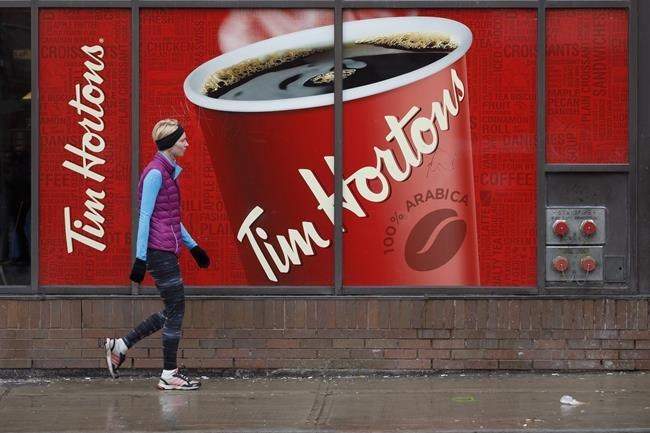Tim Hortons is modernizing its drive-thru experience and improving its core menu items in a bid to win over customers as the economy starts to reopen, executives with the restaurant’s parent company say.
The focus on positioning the coffee chain to grow during the post-pandemic recovery comes as the ongoing disruption to daily routines caused by COVID-19 restrictions continues to hurt sales.
Restaurant Brands International Inc., which operates Tim Hortons, Burger King and Popeyes, reported weaker fourth-quarter profits and revenues compared with a year ago, with sales across the three brands down 8.6 per cent.
Tim Hortons saw same-store sales slip even further, down 11 per cent, as everyday habits like stopping for a coffee and bagel before work or a hot chocolate after hockey practice continued to be curtailed by lockdowns and curfews.
“Routines remain on hold for many of our guests,” Restaurant Brands CEO Jose Cil told analysts during a conference call. “Breakfast remains significantly impacted at Tims Canada.”
But the company has invested heavily in upgrading the core offerings at Tim Hortons as part of its “back to basics” plan.
The coffee chain has introduced fresh coffee brewers, new water filters, a new dark roast coffee, fresh eggs, new lunch sandwiches and dairy alternatives.
Restaurant Brands is also rolling out more digital drive-thru menu boards, currently installed in about half the Tim Hortons locations in Canada that have a drive-thru.
"We can't control the virus and we can't control the lockdown but we certainly can control the experience that our franchisees or teams and our guests are having in the business every day," Cil said.
"We feel that we're well positioned when things begin to open up to be able to capture more share and continue to grow the business in Canada for the long term."
The digital menu boards open up new ways the coffee chain can improve customer service as they use customer information to determine what to display, Restaurant Brands chief corporate officer Duncan Fulton said.
The menus can integrate the chain’s loyalty program and add payment capabilities, which make drive-thru service more personalized and faster, he said.
“It’s giving us a really powerful marketing tool to be able to better tailor offers for our guests,” Fulton said in an interview, noting that one-third of adult Canadians use the Tim Hortons loyalty program.
“We've also learned a lot in terms of how we can simplify those digital menu boards to really target and tailor the messages that you see based on your previous shopping habits.”
Restaurant Brands chief operating officer Josh Kobza told analysts that digital sales at Tim Hortons represented 23 per cent of total sales in Canada during the quarter – more than double what it was a year ago.
In addition, Tim Hortons delivery sales are up about 14 times, he said.
“This continued momentum reinforces our belief that the wave of digital adoption we've seen in the wake of the pandemic has represented a step change in terms of how our guests interact with our brands and how we serve them going forward,” he said during the call.
Indeed, the coffee chain is banking on its modernized drive-thru menus and improvements to its classic food and beverage items to help it win market share once the economy reopens.
“We know that billions of dollars will move back to the restaurant sector as all the stay at home orders lift and as we get into vaccination,” Fulton said.
“We strongly believe that there is no restaurant in the country that is better positioned to come out of COVID than Tim Hortons.”
Yet even as sales declined in the three months that ended Dec. 31, Cil said there were early signs of recovery.
"Our December exit rate was high single-digit negative, which is the best performance we've seen since the onset of COVID," he told analysts.
"Obviously we're not doing cartwheels on that but we are encouraged by the performance and the improvements."
The coffee chain's drive-thru business has also performed better throughout the quarter, he said, with sales roughly flat compared to the same quarter last year.
RBI raised its quarterly dividend by a penny to 53 cents US per share.
The increased payment to shareholders came as Restaurant Brands, which keeps its books in U.S. dollars, reported net income attributable to common shareholders and non-controlling interests of US$138 million or 30 cents per diluted share for the quarter ended Dec. 31.
The result compared with a profit of US$255 million or 54 cents per share a year earlier.
Revenue totalled US$1.36 billion, down from US$1.48 billion.
On an adjusted basis, Restaurant Brands said it earned U$247 million or 53 cents per share for the quarter, down from an adjusted profit of US$351 million or 75 cents per share a year earlier.
This report by The Canadian Press was first published Feb. 11, 2021.
Companies in this story: (TSX:QSR)
Brett Bundale, The Canadian Press



